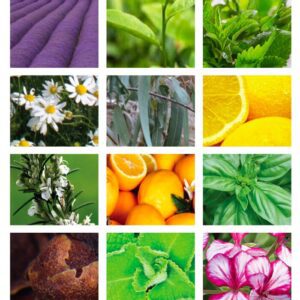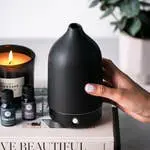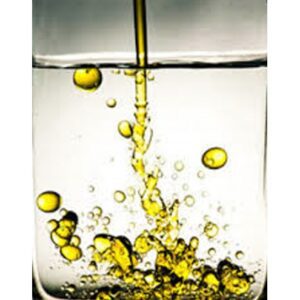Basil Essential Oil
$4.19 – $91.93
| Botanical Name: | Ocimum basilicum |
| Geographic Origin: | India |
| Method of Farming: | 100% Pure – Conventional |
| Method of Extraction: | Steam Distillation |
| Part of Plant: | Leaves & flowering tops |
Profile
“The smell of basil…taketh away sorrowfulness and maketh a man merry and glad.” (John Gerard, 16th century herbalist, Tisserand R. The Art of aromatherapy, 2nd edn, The C.W. Daniel Company Limited, Great Britain, 1979)”
Basil is an annual herb, which grows to about 1 ½ ft high. The oil is steam distilled from the leaves and flowering tops of O.basilicum. Its color is pale-yellow to colorless. Basil Essential Oil has a sweet-spicy, slightly green, fresh top note and a balsamic-woody undertone.
Basil has a refreshing and uplifting effect – useful for fatigued minds and helpful for clarity of thought whilst studying or working.
The Aromatherapy Place offers a variety of AUROMA Basil Essential Oils to suit your preference. Over time, treat yourself to a special sensual experience by trying and comparing the qualities of each. There are slight variations in odor, color, and the levels of constituents within each oil. However, the oils are similar and can be used in place of one another.
FACT: Basil takes its name from Latin for a royal ‘basileum,’ possibly because the plant was so highly prized that it was considered a king among plants.
Additional information
| Weight | N/A |
|---|---|
| Dimensions | N/A |
| Select Size | 1/3 fl oz (10ml), 3.38 fl oz (100ml), 33.81 fl oz (1kg) |
Auroma Quality
To meet the stringent demands of the professional aromatherapist, AUROMA has drafted the following seven requirements that an essential oil needs to meet so it can be used with confidence:
- BIO-TYPE: Not only does an oil have to come from a defined botanical species, but from a particular genetic strain.
- CHEMO-TYPE: The same botanical species can often produce completely different constituents.
- GEO-TYPE: Oils from a particular area are often of superior quality. Examples are Rose Oil Bulgarian or Sandalwood East Indian.
- COMPLETE OR WHOLE: The oil should come from a single distillation and should not be rectified.
- WILD OR ORGANIC: Where possible, AUROMA always selects the wild growing plants for distillation. When wild types are not available, AUROMA commissions farmers who do not use pesticides or chemical fertilizers. Certified Organic options are available.
- EX STILL: AUROMA distills small lots of expensive oils in-house and advises farmers on distillation methods.
- ANALYYSIS: Oils are tested by AUROMA in Australia with the most advanced state-of- the-art equipment in the world.
Uses
- Just to smell: You can enjoy the aromatherapy of your favorite Essential oil or Blend without even taking it out of the bottle. Keep a bottle in your purse or your car. Simply open-up and smell. This can be particularly helpful during times of stress.
- As a massage oil: Combine Basil essential oil with Geranium and Orange essential oils for an uplifting aromatic massage. When applying essential oils or blends on the skin, a carrier oil should always be added to the mix to protect the skin from being irritated. For best results, all massage formulas should be massaged for at least 30 minutes. See “Cautions.”
- Steam inhalation: Add 10 drops of your Essential Oil or Blend to a bowl of hot water. Drape a towel over your head, clothes your eyes, and inhale the vapors. Select from the following suggested oils.
- In a Diffuser: Use a diffuser with Basil to promote a sense of focus while studying or reading.
Blends With
Black Pepper, Cedarwood, Clary Sage, Coriander, Cypress, Fennel, Geranium, Ginger, Jasmine, Juniper, Niaouli, Orange, Palmarosa, Pine, Rosemary, Sage, Tea Tree, Thyme varieties and Citrus oils.
Whenever you use Essential Oils or 100% pure Essential Oil Blends on the skin, they should be diluted in a vegetable oil. However, always check for skin sensitivity before applying the finished product to the body. See “Cautions” below.
Suggested Dilution Rates follow:
- 10ml Base Product: A 1% dilution requires a total of 2 drops essential oil, or a pure blend, 2%=4 drops, 2.5%=5 drops
- 50ml Base Product: A 1% dilution requires a total of 10 drops essential oil, or a pure blend, 2%=20 drops, 2.5%=25 drops
- 100ml Base Product: A 1% dilution requires a total of 20 drops (1ml) essential oil, or a pure blend, 2%=40 drops (2ml), 2.5% 50=drops (2.5ml)
- 1Ltr Base Product: A 1% dilution requires a total of 200 drops (10ml) essential oil, or a pure blend, 2%=400 drops (20ml), 2.5%=500 drops (25.ml)
Please ensure that the total number of drops does not exceed the dilution ratio. For example: 2.5% dilution = 1 drip Geranium, 2 drops Palmarosa & 2 drops Mandarin diluted in 10ml Jojoba Oil. Total drops = 5
Cautions
Basil is mildly toxic when ingesting 34 fl oz to 68 fl oz. It is a very mild skin irritant which does not cause skin sensitization or phototoxicity. (Tisserand R, Bolacs T, Essential oil safety. Churchill Livingston, UK)Basil oil is contra-indicated during pregnancy. (Davis P, Aromatherapy: An A-Z, 2nd edn, The C.W. Daniel Company Limited, Great Britain, 1999)
The Aromatherapy Place does not recommend ingesting essential oils unless a specific dosage instruction is given to a consumer by a qualified medical practitioner.
Do not apply directly to skin. May case skin irritation in some individuals. Always dilute with a carrier oil. A skin test is recommended prior to use on the skin.
Keep out of reach of children. If you are pregnant, nursing, taking medication, or have a medical condition, consult a health professional prior to use. Keep away from eyes and mucous membranes.
Please check with a professional for safe essential oils to use with children or the elderly. Do not use essential oils on a child younger than two years without professional advice.
Storage
We recommended that Essential Oils or 100% pure and natural Blends be stored in amber or cobalt blue glass containers to maintain freshness and attain maximum shelf life. Keep away from excessive heat and light. A bathroom, bedroom or kitchen cabinet should be a good storage location.












